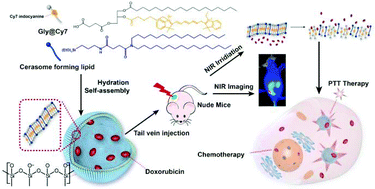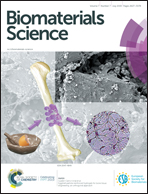Highly stable near-infrared dye conjugated cerasomes for fluorescence imaging-guided synergistic chemo-photothermal therapy of colorectal cancer†
Abstract
Colorectal cancer is a common malignant tumour with a low 5-year survival rate. A combination therapy with high selectivity and easy controllability is a pressing need for the effective treatment of such cancer. In this study, an indocyanine green derivative (Cy7)-conjugated lipid with a terminal carboxyl group was synthesized, which could self-assemble with a cerasome-forming lipid (CFL) into nanoparticles (NPs) by encapsulating doxorubicin (DOX) to achieve combined photothermal chemotherapy. The resulting Gly@Cy7-Si-DOX NPs with a surface covalent silicate framework showed excellent morphological stability and colloidal stability. Specifically, the conjugated Cy7 was covalently conjugated in the liposomal bilayer, resulting in high drug loading content, high photostability, and high photothermal conversion efficiency, which enabled the resulting nanoparticles to be an effective platform for photothermal therapy. Meanwhile, the encapsulated DOX leaked only slightly under physiological conditions due to the silicate surface of Gly@Cy7-Si-DOX NPs and exhibited controlled release in a weakly acidic environment or under near-infrared (NIR) light irradiation for chemotherapy. Gly@Cy7-Si-DOX NPs were efficiently taken up by tumour cells. Upon light irradiation, the released DOX entered the nuclei of tumour cells, as observed by confocal microscopy and flow cytometry. In vitro cell experiments indicated that both healthy cells and tumour cells were viable under treatment with only Gly@Cy7-Si-DOX NPs, indicating the encapsulated DOX was stably confined to the NPs, and cells were significantly killed when treated with both Gly@Cy7-Si-DOX NPs and NIR laser irradiation. After i.v. administration, Gly@Cy7-Si-DOX NPs accumulated at the tumour site, as monitored by near-infrared fluorescence imaging. A significant tumour inhibition rate (95.8%) was also achieved in a HT-29 colorectal cancer model when treated with Gly@Cy7-Si-DOX NPs plus irradiation. Therefore, the Gly@Cy7-Si-DOX NPs hold great promise for controllable combined colorectal cancer photothermal chemotherapy.



 Please wait while we load your content...
Please wait while we load your content...